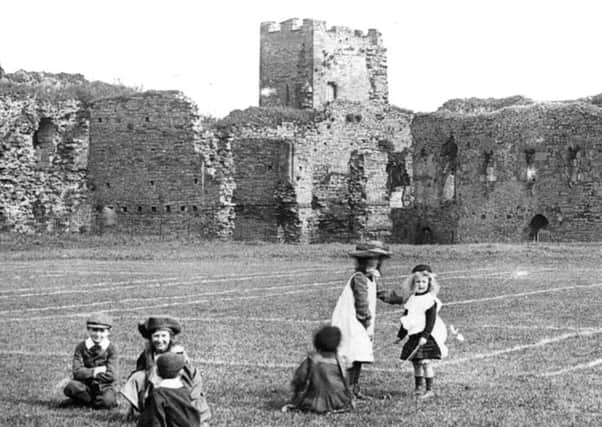Nostalgia on Tuesday: King of the castles


One of the men to receive a reward was Alan Rufus.
During 1069 William the Conqueror had put down a rebellion at York and this was followed by his ‘harrying of the north’ – often described as an act of ethnic cleansing. As a further punishment, he divided up the lands of north Yorkshire. Alan Rufus, of Brittany, received the borough of Richmond and other parts of eight counties including Yorkshire, Norfolk, Suffolk, Dorset and Surrey. All this became known as the Honour of Richmond.
Alan Rufus built Richmond Castle in 1071, on a virgin site, and it was laid out with a new settlement. The castle was built for a number of reasons: as a front-line stronghold against the Scots and Danes, besides quelling any further Yorkshire uprisings; a base for his garrison of knights; a symbol of his power and for it to be a centre of financial control.
Advertisement
Hide AdAdvertisement
Hide AdHe named it Riche-Mont (strong hill) and it stands in a commanding position above the river Swale.
As a settlement, Richmond grew because of the castle, providing what was necessary to the builders and in time the household. A market established nearby was awarded legal standing by a charter in 1093.
Information displayed at Richmond visitor centre states in medieval England (c. 500-1500), castle-builders were in great demand. Castles were built by master craftsmen who moved around the country, from site to site. The most important craftsmen were the masons and the carpenters. Building work took place during the summer months and the master mason was in charge of the entire project. As well as being the architect and site foreman, he hired all the craftsmen and workers. Unfortunately, the identity of the master mason at Richmond is unknown.
The castle consists of a triangular main enclosure and within it are a number of noteworthy structures: St Nicholas’s chapel, the Keep or Great Tower and Scolland’s Hall.
Advertisement
Hide AdAdvertisement
Hide AdNamed after Alan Rufus’s steward, Scolland’s Hall on the castle’s south-east side was a domestic hall, where the earl and his family lived when he was in residence. Heavily fortified, it was the castle’s most defended part until the keep was built.
Alan Rufus’s great nephew and Earl of Richmond, from 1146 to 1171, built the magnificent Great Tower or Keep rising some 100ft.
From the Norman Conquest onwards the most impressive English castles were given robust authority by huge stone towers, nearly always rectangular in plan and with thick walls. Visible today at ground-floor level is a stretch of the original 11th-century curtain wall and the main castle entrance.
It is thought Richmond Castle once had about 30 knights living there, charged with guarding the castle from any threats from the surrounding areas. An earl would constantly move around his estates in various parts of England and Brittany. While away, he would sometimes leave his wife to run the household and estate. If both the earl and his wife were away a loyal and competent constable would be left in charge to run the estate and collect taxes. The high-ranking position, often hereditary, had been earned through service to the earl.
Advertisement
Hide AdAdvertisement
Hide AdOne panel in Richmond’s visitor centre states that most of the earl’s business was carried out at court. “London was the place to be and it is likely that many of the earls never visited Richmond Castle... The castle had given rise to the town and for many centuries it controlled everything that happened there. But eventually the town outgrew the power of the castle and found a life of its own.”
The castle passed down through the ownership of several powerful individuals as well as the Crown but fell into ruin from the 15th century.
From the mid-18th century there was an interest among artists to capture historic landscapes. Richmond and its castle was of particular interest and attracted, besides others, the noted leading British watercolourist of the time JMW Turner. He made a series of famous sketches and watercolours of the castle.
In 1854 the Duke of Richmond leased Richmond castle to the North Yorkshire Militia and a castellated barrack block was erected along the length of the west curtain wall. Robert Baden-Powell, who was to become founder of the Boy Scouts movement, lived there while commanding the Northumbrian division of the Territorial Army from 1908. Two years later, parts of the fortress came under the care of the Office of Works
Advertisement
Hide AdAdvertisement
Hide AdDuring the First World War the castle had a controversial role. It was used as the base of the Non-Combatant Corps made up of conscientious objectors. These included the ‘Richmond Sixteen’ who were taken to France from the castle, charged under Field Regulations and then sentenced to death, though this was later commuted to 10 years’ hard labour.
The castle’s Victorian army barracks were demolished in 1931 and a year later an excavation of the castle well in 1932 discovered pottery, glass, leather and animal bones. During the Second World War part of the castle was used as a prison for regular soldiers.
Now under the care of English Heritage, the castle is a Grade I-listed building. An English Heritage guidebook states: “No other castle in England can boast so much surviving 11th-century architecture – it is probably the best-preserved castle of this scale and age in the country.”